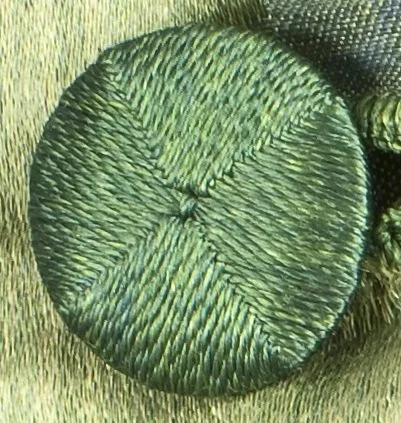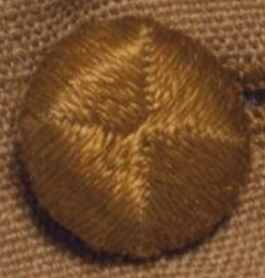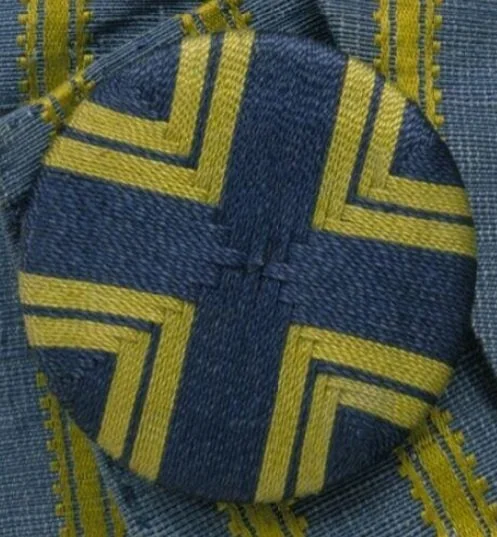Silk-wrapped buttons in the 18th century
The garments and portraits on this linkspage provide examples of silk thread-wrapped buttons, including death’s head buttons and striped buttons. See the links in the Additional Resources inset for instructions that will help you make your own buttons, as well as places where you can buy your own button molds to make your own buttons.
A letter published in The Gentleman’s Magazine in 1807 muses on 18th century buttons:
There were two ſorts of buttons known to the taylors, death’s head and baſkets; the former were covered with flos ſilk, diverging in quarters from the centre, like the ruſhes at the bottom of a chair; the latter were woven ſomething like baſket-work, and were not confined to black, but were indifferently of any colour to ſuit the cloth.
Silk twist buttons like these were made in Leek and Macclesfield in the 18th century. (Macclesfield was particularly known for its buttons in the 18th century, as noted in A description of the country from thirty to forty miles round Manchester, A concise history of the county and city of Chester, and even The young English scholar’s complete pocket companion. A history of Macclesfield has a particularly interesting description of the button-making trade and how it boosted the local economy.) The local trade continued in the area into the late 19th century.
A general description of all trades describes three trades involved with this process: the button-mould-makers (“The Mould of a Button is the Inſide, or the hidden Part, on which the Silk, Twiſt, Metal, &c. is wrought, and is the main Support of it. They are cut out of Wood and Horn, by a particular Hand-inſtrument, at once ſhaping them to any Size required, which differ as often as the Modles of Buttons”), the button-makers (“who cover the Moulds with divers ſorts of Twiſts, &c. in many curious Mixtures and Shapes, on which many Women work”), and the button-sellers (“These are Shop-keepers, who ſell all ſorts of Buttons, and what generally goes with them, viz. Twiſts for making the Button-holes, &c.”) See also The complete dictionary of arts and sciences for more on the making of buttons and button-molds.
In the 18th century, the “ſilk twiſt button, called death head” was also exported to America in addition to its spread in England and on the Continent. They are listed in newspaper advertisements describing goods imported from England, including Rhea and Wikoff of Philadelphia (“ſilk and hair death head buttons,” The Pennsylvania Gazette, January 7, 1755), John & Thomas Worthington of Baltimore (“Mohair & Horſe-hair Buttons, Mohair & Silk Twiſt, fine Scarlet, Death-head Buttons,” Maryland Gazette, August 19, 1762), Walter Mansell of Charleston (“gold and ſilver baſket and death-head buttons,” The South-Carolina Gazette, March 16, 1765), Hudson & Thompson of Baltimore (“Baſket and Death-head Buttons … Silver and Gold Twiſt Buttons,” July 6, 1769), Samuel Howell and Son of Philadelphia (“basket and death head buttons,” The Pennsylvania Journal, September 19, 1771), Oliver Cromwell of Charleston (“large Death Head-Buttons of all Colours,” The South-Carolina Gazette, December 13, 1773), David Lamb of Charleston (“Metal and death-head buttons,” The Royal South-Carolina Gazette, May 9, 1782), and Isaac Hazlehurst of Philadelphia (“metal and death head buttons,” Poulson’s American Daily Advertiser, September 21, 1784). “WILLIAM SMITH, a Scotchman, who is about 23 years of age,” who ran away from Newcastle, Virginia, in 1774, took “a Newmarket coat of light bath coating, not bound, but ſtitched on the edges, with death head buttons on it” (Virginia Gazette, January 26, 1775).
Additional Resources
This site contains affiliate links for which I may be compensated
Macclesfield Museums: How we became The Silk Town
The Silk Museum in 5 Objects
Instructions for Making the Deathshead Thread Button from Wooded Hamlet Designs
Blogs about button-making: Fabric & Fiction, A Fashionable Frolick, Not In a Museum, Slightly Obsessed, Contemporary Makers
Video tutorials:
Gina-B Silkworks’ How to Make a Death’s Head Button / 18th century thread button tutorial and Making Buttons DVD
Burnley & Trowbridge: Learn to Hand Sew: Thread Button
Vincent Briggs’ 18th Century Death’s Head Buttons
Cécile du Jard’s deathhead-button tutorial, part I, part II, part III
Amy Lee Karow-Thara’s guide to creating a multicolor death head button
Death Head Buttons: Their Use and Construction
Buttons: A Passementerie Workshop Manual
Piecework Magazine July/August 2013
Button molds are available from Burnley & Trowbridge, Wm. Booth Draper, and Gina-B Silkworks.
Death’s Head Buttons (in solid colors)
National Trust 1402355, a man’s sleeved waistcoat or jacket, c. 1730-1740
Manchester 1959.51, a man’s coat, 1730-1750
Chicago History Museum 2380-14H, an embroidered silk coat that Jabez Hamlin wore at his wedding in 1736
National Trust 1402230, a man’s country coat, 1740
Met 1982.275a, b, an Italian silk cassock, c. 1740
John Bright Collection riding jacket, 1740s
Meg Andrews 8232, a Dutch boy’s coat
Johann Ludwig Aberli by Jakob Emanuel Handmann, 1751
Captain John Pigott by Joseph B. Blackburn, 1752
V&A T.197-1984, a woman’s riding coat, 1750-1759
National Trust 1349006, a man’s waistcoat (with two of its original death’s head buttons), 1750-1760
Manchester 1960.301, a man’s banyan, 1750-1760
LACMA M.2007.211.797, a man’s banyan, 1750-1760
Met 2008.75, a man’s banyan, c. 1760
Theodore Atkinson, Jr. by John Singleton Copley, c. 1757-1758
An unknown man in a landscape by George Romney, c. 1758-1760
Thaddeus Burr by John Singleton Copley, c. 1758-1760
V&A T.198-1984, a woman’s riding habit coat, c. 1760
Samuel Richardson by Mason Chamberlin the Elder, c. 1760
Meg Andrews 7998, waistcoat embroidered in Suzhou, China for the export market, assembled in Britain, 1760s
Timothy Fitch by Joseph Blackburn, c. 1760-1775
Thomas Wentworth by Joseph Blackburn, 1761
James Warren by John Singleton Copley, 1761-1763
Probably John Trevor, third Baron Trevor by Arthur Devis, 1763
Peter Perez Burdett and his First Wife Hannah by Joseph Wright of Derby, 1765
Met 1991.46, a man’s coat, c. 1765
A man of the Jones family, 1765-1770
Portrait of a man known as the Indian Captain by Joseph Wright of Derby, c. 1767
National Trust 1349034, a man’s sleeved waistcoat, 1770-1780
John Philip de Haas by Charles Willson Peale, 1772
Francis Malbone and his Brother Saunders by Gilbert Stuart, c. 1773
Mr. and Mrs. Thomas Mifflin (Sarah Morris) by John Singleton Copley, 1773
Capability Brown by Nathaniel Dance (see also NPG 1490 and Burghley PIC211)
Benjamin Waterhouse by Gilbert Stuart, 1775
Met 1981.14.2, a woman’s riding waistcoat, c. 1775
Mr. and Mrs. Ralph Izard by John Singleton Copley, 1775
Thomas “Sense” Browne by Nathaniel Dance-Holland, 1775
Louis de Visme by Anton Raphael Mengs
NT 1349019, a man’s waistcoat, 1775-1785
Peter Oliver by John Downman, 1776-1791
Samuel Mifflin by Charles Willson Peale, 1777-1780
Patrick Tracy's 1778 silk coat he wore at the age of 67
Sir Abraham Isaac Elton 4th Bt by Thomas Beach, c. 1780-1790
National Trust 1349032, a man’s waistcoat, 1780-1790
National Trust 1349033, a man’s waistcoat, 1780-1800
Samples of Macclesfield buttons, late 18th century
Oliver Wolcott by Ralph Earl, c. 1789
David Baldwin by Ralph Earl, 1790
Reuben Hull Booth by Ralph Earl, 1790
Self-portrait of Archibald Skirving, c. 1790
Juliane Gottliebe Elizabeth Becherer by Joseph Friedrich August Darbes
Historic New England 2006.44.1293AB, a woman’s cloak, c. 1800
Multicolored or striped thread-wrapped buttons
These striped buttons appear more frequently later in the 18th century and coordinate with the color combination on the garment.
Kerry Taylor Auctions Apr 8 2014, lot 140, a gentleman’s waistcoat, 1760-1770
Manchester 1962.222, a man’s waistcoat, 1760-1780
LACMA M.2007.211.718, a woman’s robe à la française, c. 1770
London Museum 77.104, a printed cotton waistcoat with silver tambour work, c. 1771-1774
Met 2005.61a, b, a silk dress (robe à la française) made in France c. 1775
Charles A. Whitaker Lot 512, a man’s striped silk coat, 1775-1790
National Trust 1349031, a man’s waistcoat, 1780-1790
V&A T.92-1962, a man’s frock coat, 1785-1790
Meg Andrews 9169, a Maze and Steer silk waistcoat from the family of Thomas Crewe Dod, England, late 1780s-early 1790s
KCI AC5146 85-28-2AC, AC5667 87-35-1, a man’s suit, 1790s
Missouri History Museum 1933-038-0001a-b, green and cream striped silk taffeta coat and waistcoat worn by Pierre Bauduy de Bellevue, 1790-1800
Waistcoat, end of the 18th century







